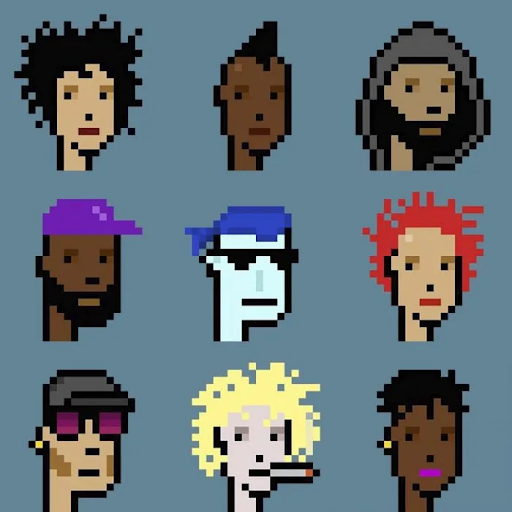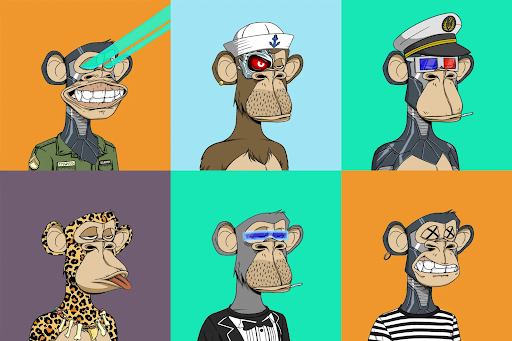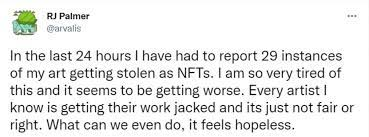Let’s admit it, 2022 didn’t start off too bright.
With the loss of a beloved actress Betty White earlier in January of this year, and the growing prominence of the new Coronavirus variant, an infamous trend from mid to late 2021 was starting to grow more concerning in companies.
People online quiver at the mere thought of the subject of “NFT’s.” For those who haven’t been in the loop for a good few months, NFTs are “Non-Fungible Tokens.”
A good chunk of NFTs consist of a unique digital asset, like a piece of artwork, file, or MP4, in which they’re bought with something called ‘cryptocurrency.’
People have been heavily both for and against NFTs. People say that they help cryptocurrency grow bigger, and could eventually replace our current money system. Others think that all NFTs do is create money laundering schemes, steal art, and hurt the environment.
But what a lot of people don’t seem to ask that often is “are NFTs considered real art?” Which, in of itself, is a strange question—but also, something to consider.
However, to fully understand NFTs, we should figure out where they actually came from. It is a peculiar case.
For starters, they didn’t start back in 2021. They were around for so much longer, since 2012 actually.
However, when it comes to the concept of selling unique art pieces with cryptocurrency, the first NFTs were the CryptoPunks. Which are just tha—pixel art of punks sold for crypto. Simple enough as it is.

However, many more different kinds of NFT art are being sold and manufactured daily. But, at what cost exactly?
A lot of the cryptocurrency is derived from another cryptocurrency called Bitcoin, which is controversial in of itself. Why? Because of its environmental damage.
The energy from Bitcoin is tied to the energy from other nations, like Malaysia, Finland, and Sweden. Yet, the sectors that collect that same energy are closely associated with pollution, like carbon emissions.
And that’s just the currency itself. The transactions of the currency (like when someone uses Bitcoin to buy something such as a NFT) cost more energy. It takes over 1,700 kWh of electricity, which is more than the average use of electricity in someone’s own home.
Also, taking into account that most cryptocurrencies are made from Ethereum, it takes a lot to produce it, most often loads of Bitcoin miners and machines. More machines, more electricity going to waste. More electricity, more pollution.
Let me put it into perspective: A currency that doesn’t even have a physical form that you use to buy cheap looking art costs more electricity than the average home.
But now, what about the art itself? Well. . .
The art itself is pretty controversial, mostly because of the way most NFT art looks. If it’s an original piece, then it looks ugly as sin. Take one of the more infamous NFTs as an example.
The BAYC.
A.K.A., the “Bored Ape Yacht Club.”
Even if you’ve never heard of the name of this particular NFT, you’ve definitely seen it.

These… “art pieces” are bet for millions of cryptocurrency. Why? I wish I could find an answer to that.
These apes in particular have grown very popular. Like, VERY popular. People have wasted so much crypto on these “fairly priced,” “unique,” and “valuable” pieces.
I say valuable, but in the age of the internet and heavily advanced technology, it’s so easy to screenshot these pieces, and use them for whatever purpose. But, not sure why you would though. These things don’t even look valuable.
However, because Gordon Goner, Gargamel, No Sass, and Emperor Tomato Ketchup (the people behind BAYC) made so much money from these custom trash heaps, they even started a pilot for a show featuring the NFT avatars.
Yes, an NFT cartoon. And it’s as dumb as it sounds.
Of course, it technically wasn’t the first NFT comedy cartoon. That title goes to the Stoner Cats.
However, this just proves the growing (and concerning) popularity of NFTs. If people are buying these so often that they’re making cartoons to cash in on them even more, these things are only going to get worse.
And those aren’t the only bad things NFTs have done.
A growing issue involving NFTs is art theft. Take art platforms like Artstation or Deviantart, who each have very massive artist fanbases. Now, take something as profitable as NFTs, an ever growing so-called “art” medium.
Put two and two together, and you have an even bigger money laundering scheme.
Many artists suffer from a lot of theft from their works. From tracing their works, ‘art fixing,’ (which is a whole other issue) and reposts from people claiming ownership, NFTs certainly aren’t making things easier.
One of the many artists who have spoken out about the dangerous landscape of NFT art theft was Twitter user ‘arvalis,’ better known as RJ Palmer, who is known for their realistic Pokemon artwork stolen for NFTs and speaking up about on their twitter handle.

And this isn’t just happening on Twitter. On Deviantart, one of the biggest art websites, they had to implement a feature where they can detect artists getting their pieces stolen for NFTs.

With NFTs becoming a new currency medium, and their chance of dying out close to zero, these issues will only get worse if nothing is done. No moderation on art theft and quality control is going to ruin their reputation more.
It also doesn’t help that they use so much energy. Worst case scenario—the transactions of too many stolen NFTs is gonna use so much electricity, that there’ll be no more electricity to make and sell them with all the pollution they’re so closely tied to.
Remember: the more machines, the more electricity wasted. More electricity, the more pollution these dastardly art pieces cause to everyone else.
And no one wants electricity to be wasted on horrible monkey drawings, pixel art punks, or stolen artwork from independent artists who want nothing to do with the horrendous controversy that are NFTs.



